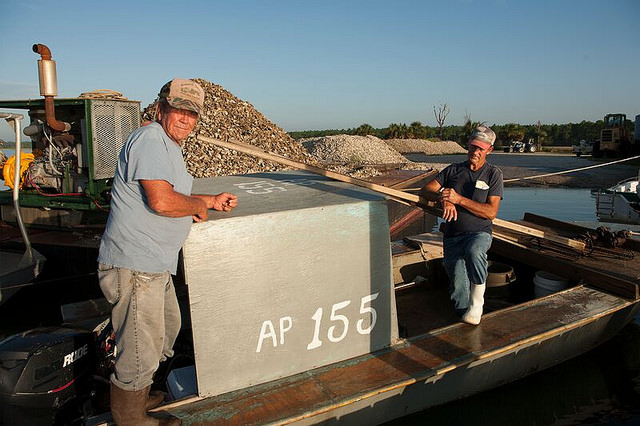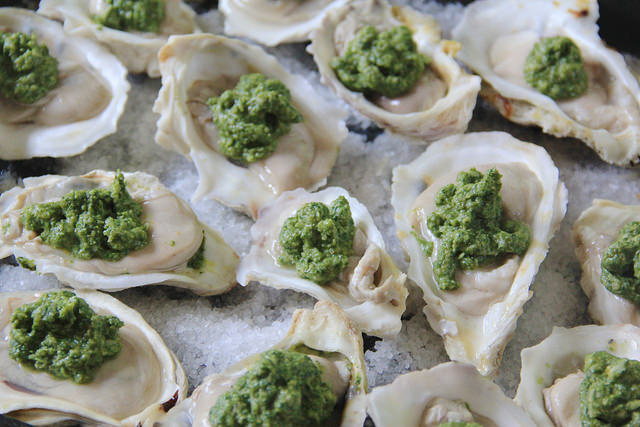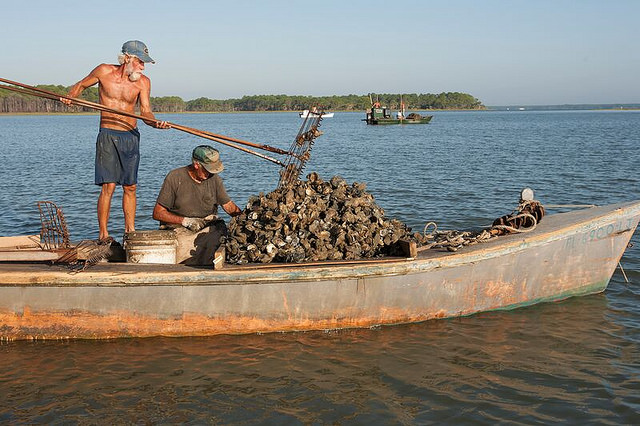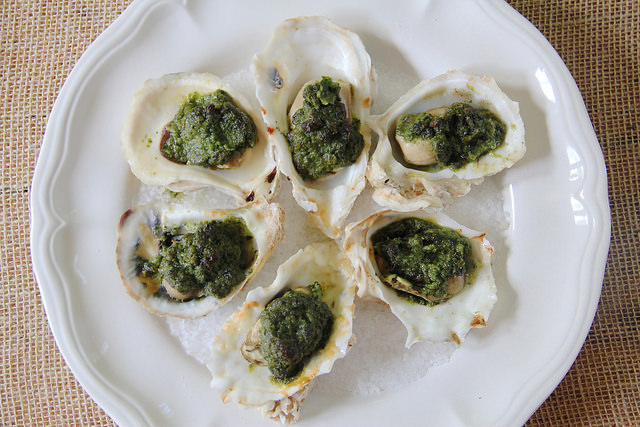Recipe Contributor: Caroline Coker
Writers: Susan Benton and Caroline Coker
Apalachicola, the old city on the “Forgotten Coast” that produces fresh wild oysters — not farmed — is not that far off, which makes our region the premiere destination for all things having to do with bivalves. Unfortunately, after the over harvesting from Hurricane Katrina, and the current water wars with Georgia and neighboring states, the Apalachicola oyster beds have declined greatly in numbers, but they are still there.
Locals and tourists alike can’t get enough of ice-cold oysters, and on the Gulf Coast they are a savored delight. Some folks may even be reminded of the famed food writer M.F.K. Fisher’s book, “Consider the Oyster.” Definitely one you should pack in your beach bag, it begins with Fisher paying tribute to the most enigmatic of foods as she writes an entertaining synopsis of the life cycle of an oyster, calling it “dreadful but exciting.”
The excitement begins when adult oysters begin reproducing at water temperatures greater than 68 degrees, typically occurring from May to October. As broadcast spawners, the oysters release eggs and sperm into the water column, and once fertilized, the egg develops into larva (spat) that remains free swimming for three weeks. Towards the end of this period a foot or pedi veliger develops, and the oyster settles to the bottom of the water column looking for a hard substrate. Once a hard surface like an oyster shell is located, the larva cements itself, and the metamorphoses to the adult form occurs. The spat cannot grow until it finds a hard surface. Gulf oysters feed mainly on single-cell plants and flourish in estuaries, where nutrient-rich fresh water rivers meet coastal saltwater.

History
Rich in history, Apalachicola began commercial harvesting of oysters in 1850, and it is a unique fact that the Union Navy allowed oyster harvesting to continue uninterrupted in Apalachicola Bay during the Civil War, even though the Federal blockade of the Southern coast was in effect.
By 1907, Apalachicola Northern Railroad ran oyster specials to Atlanta with oysters packed on ice, which paved the way for the country to enjoy these majestic mollusks.
Apalachicola oystermen are but a few who continue to manually harvest with oyster tongs, the last place in coastal waters where this is still tradition. They can be seen using the long-handled wooden sticks while out in the Apalachicola Bay; their small boats and skiffs in the estuaries where oysters are scooped from the sandy bottom beds.
Nutrition
Just one cup of raw oysters (out of the shell of course) contains 169 calories, 2 grams of fat, 10 grams of carbohydrates and packs a protein punch with 17 grams. A great source of zinc and omega-3s, oysters are not only delicious but good for you! The flavor an consistency of the world’s oysters vary widely, but the manners in which they are enjoyed vary equally. Fancied up, raw, baked, steamed or stewed, here is a family recipe, handed down through my New Orleans heritage that most are familiar with.

Oysters Rockefeller
Serves 6 appetizers, or 12 as a meal
Oysters Rockefeller is a dish that was created in New Orleans where my paternal side of the family has resided for several generations. My twist on the recipe originating at Antoine’s restaurant, is definitely a Crescent City classic.
Ingredients:
1/2 cup chopped fennel (bulb only)
1/4 cup chopped leeks (green and white parts)
1/4 cup finely chopped fresh parsley
2 green onions, finely chopped
1 rib celery, finely chopped
3 cloves fresh garlic, finely chopped
1/4 cup ketchup
1 1/2 cups chopped frozen spinach, cooked and drained
1 teaspoon salt
1/2 teaspoon cayenne pepper
1/2 teaspoon white pepper
1 teaspoon dried thyme
2 teaspoons Worcestershire sauce
1/4 cup Herbsaint liqueur
1 cup melted butter
1 cup heavy whipping cream
1/2 cup grated parmesan cheese
1/2 cup seasoned dried breadcrumbs
6 dozen oysters on the half shell
12 cups rock salt
12 lemon wedges for serving
Directions:
Preheat oven to 375°F degrees.
In a food processor, combine fennel, leeks, parsley, green onion, celery, ketchup, spinach, garlic, salt, pepper, cayenne, thyme, Worcestershire, and Herbsaint. Purée mixture thoroughly. Scrape into a large mixing bowl. Add butter. parmesan cheese, and breadcrumbs. Stir in the cream, blending well.
Pour enough rock salt into 12 eight-inch cake pans to cover bottoms. Arrange six oysters in their half shells in each pan.
Fill a pastry bag (or gallon size freezer ziplock bag with the tip cut off) with Rockefeller sauce and pipe equal portions of sauce over each shell or use a large tablespoon to distribute sauce. Bake 10 minutes until sauce sets. Increase heat to broil; broil oysters until tops are bubbling, but not burning. It may be necessary to bake the oysters in batches.
To serve, line each of six dinner plates with cloth napkins that have been folded into neat squares. Nestle pans of oysters into folded napkins. Garnish with lemon wedges. Serve at once.
Note: If Herbsaint is unavailable, Pernod may be substituted.
Tip: If wanting to make a healthier version of this recipe, substitute good olive oil for the butter, and half & half for the whipping cream.
Tip: If ever invited to a shucking party or an oyster roast, take some of the better looking shells home with you. Soak them in clorox for a day, then set them in the sun to dry for a day or two. Wash them in the dishwasher cycle, and keep them in a bucket or basket (not sealed) so when wanting to serve fresh oysters at home (no time for shucking yourself), the shells will be readily available. Just head to you your trusted local seafood market and buy fresh oysters in a container, based on the number of guests. My mom has also bought them fresh shucked from local restaurant owners that she knows, taking the oysters home home right away to prepare immediately before an event.

Oyster Myths
Getting oysters fresh and keeping them cold is key. At Boss’s Oysters in Apalachicola they are kept chilled from “bay to belly.” Raw oysters contaminated with Vibrio vulnificus, a naturally occurring bacterium found in coastal waters can be life threatening. Infection with this organism, which is often associated with eating raw oysters, is the leading cause of seafood-related deaths in the United States. However, there are myths that encourage and discourage people from eating raw oysters. Below are a few “pearls of wisdom” on the subject.
Myth: Eating raw oysters are safe if you drown them in hot sauce, which kills everything.
Fact: The active ingredients in hot sauce has no effect on harmful bacteria. Nothing but cooking them at a high enough temperature will kill the bacteria.
Myth: Avoid oysters from polluted waters and you’ll be fine.
Fact: Bacteria thrive naturally in warm coastal areas (such as the Gulf of Mexico) where oysters live and have nothing to do with pollution. (The reason I enjoy eating them in cooler water months, as well as avoiding spawning season. Again, personal preference.)
Myth: Alcohol kills harmful bacteria.
Fact: Alcohol can impair good judgment, but it doesn’t destroy harmful bacteria.
Myth: An experienced oyster connoisseur can tell a good oyster from a bad one.
Fact: Don’t rely on your senses to determine if an oyster is safe. Look for the date on the box being shucked. Ask where the oysters cam from. Check the container date at the seafood market. Get to know your fish monger or oystermen/women.
Myth: Avoid raw oysters in months without the letter “R” and you’ll be safe.
Fact: Oysters are delicious year round, and when cooked properly can even be eaten by those with compromised immune systems. I personally stick to the colder months through spring.
Myth: Raw oysters are an aphrodisiac and will cure a hangover.
Fact: There is no scientific evidence that either of these commonly held beliefs is true, but we wouldn’t it be great if it was? Enjoy thinking so.
Since this article was written, farmed oysters have come a long way. Consider using the delicious Pensacola Bay, Magnolia Bluff, or Murder Point oysters in your recipes, or eaten raw. The Apalachicola oysters are in peril due to the Georgia water war crises that in April 2021, Georgia sadly won.










I love oysters but am not keen on Gulf oysters unless they’re cooked because they have such a mild flavor. Anything briny I can eat lots of, accompanied by a delicious crisp white wine! In fact, now I have a serious oyster craving!